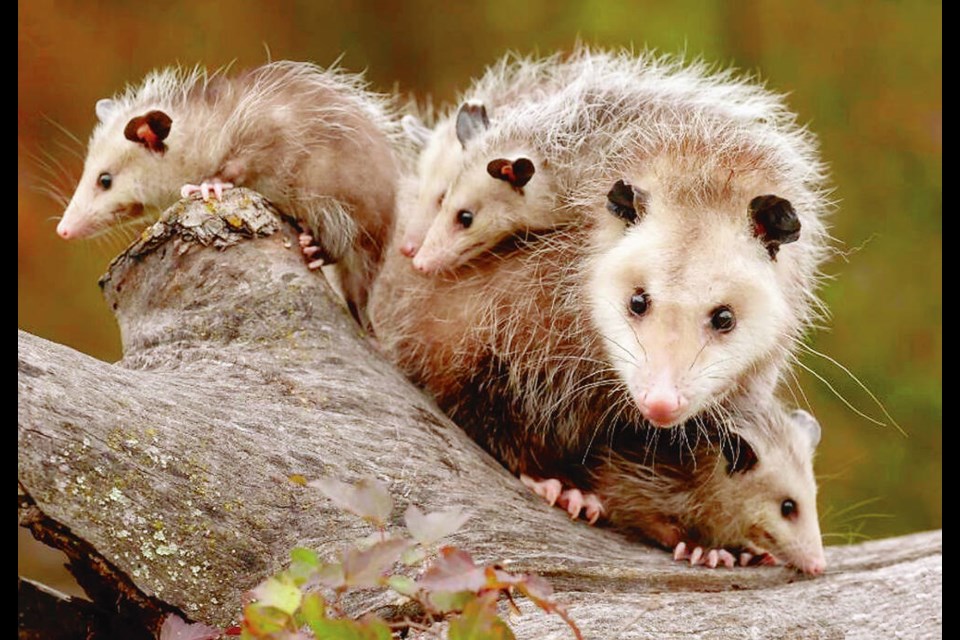There was a time on Hornby Island when you could see opossums every day, either as roadkill or getting a meal from the compost or hen house or swinging from a fruit tree.
The Virginia opossum, a cat-sized marsupial with sharp snout, beady eyes and hairless, scaly tail, was introduced to the island in the mid-1980s and proliferated quickly. Hundreds of the nocturnal creatures started roaming Hornby, tearing into gardens, rummaging through trash cans and killing chickens.
People were trapping them or taking aim with their vehicles as the animals proliferated, birthing two litters a year of between five and seven young each time.
If you have a bumper sticker of a roadkill-flattened opossum, you’re from Hornby.
But populations seem to be on the decline — or at least levelling off, if you ask the locals.
“I’m seeing a lot less of them in the past few years,” says Alex Allen, a Hornby trustee with Islands Trust who manages the community’s Co-op Gas bar.
“It used to be you would see them on the road dead every three blocks or so,” says Allen. “They are nocturnal and very cute. I would find them in my compost with their butts sticking out and they’d just look back at me and [seem to say]: ‘You like my buns don’t you?’ ”
Colleen Work, a resident of Hornby for 43 years and a maintenance worker who cleans the community hall and campground outhouses, works early morning hours and sees a lot of them. She has been defending her chickens and garden against opossums since the first pair arrived on the island in 1986.
She said a couple who moved from Maple Ridge brought them over, likely as pets. They let them go and the population took off.
Work brought Hornby’s opossum plight to the province a few years later. After several calls to doubting officials, she took a dead opossum into the Courtenay office of fish and wildlife and plopped it on the officer’s desk, saying: “That’s a possum.”
She didn’t want to guess at how many opossums are on Hornby now, but said there are fewer than the peak period about 10 years ago. “There are rumours that maybe a disease or something went through one year and killed a lot of them,” said Work.
Extensive trapping over the years may have also dented the population.
“At least I’m not finding 10 of them in my chicken house anymore like I used to.”
Work said opossums aren’t like minks, which kill and then eat chickens. “These [opossums] just grab a foot or a wing and they just start eating … it’s awful. And they create havoc in your garden, too.”
She said the animals have been known to use cat doors to go inside homes to help themselves to pet food.
Work said the opportunistic feeders are found on beaches and shorelines around Hornby, turning over rocks to eat small crabs and other marine life. She believes they also steal the eggs of ground nesters like ducks and shorebirds.
The Environment Ministry said in an invasive special bulletin that opossums will eat whatever food is available, including mammals, birds, insects and other invertebrates, as well as reptiles, amphibians, vegetation, fruit and garbage. The varied diet helps the opossum’s ability to thrive and spread where humans live.
The opossums have few predators to keep their populations in check, said Work, though bald eagles have been known to catch a few or pick up the roadkill. Eagle nest cameras on Hornby have revealed eagles feeding on opossums.
The Virginia opossum was introduced to B.C. via Washington state into the Lower Mainland and through the Fraser Valley in the late 1940s and early 1950s, said Gail Wallin, executive director of the Invasive Species Council of British Columbia, who urged people to report sightings of the animals.
“There’s not much data or field work, but when citizens help out, it can help to create that knowledge” — and maybe curb some of the damage.
The Virginia opossum, the only marsupial in Canada and the U.S., originated in South America, evolved and traveled as the Central American land bridge formed about three million years ago. The species now ranges from northwestern Costa Rica, through Central America and the eastern Unites States, to southern Ontario and Quebec — and most recently B.C. and Hornby Island.
Wallin said opossums were introduced by humans in the western U.S. as pets, food and for sport hunting and the fur trade.
Wallin said opossums, like all invasives, upset local ecosystems, especially on small islands like Hornby. “They’re very adaptive, so it’s a huge risk for native and endangered species competing for food supplies [and survival]. They out-compete and then upset the ecosystem.”
A report to the province in 1992 indicated an opossum sighting in Victoria, but had no details.
Ian Fraser, who runs Victoria Animal Control Services, said in the decades he’s been catching escaped exotic pets and introduced animal species in the region, he’s never run across or heard about an opossum.
But he has answered calls about dead raccoons floating in the ocean that are sometimes mistaken for opossums because of decay and hair loss.
According to the Environment Ministry, Virginia opossums are among a group of animals where licences are not required to hunt, capture or kill. Others include the European rabbit, eastern cottontail, American bullfrog and nutria.
Report invasive species sightings to the province at https://bit.ly/2OzkU7Z, or to the Invasive Species Council of B.C. at bcinvasives.ca/take-action/report.
>>> To comment on this article, write a letter to the editor: [email protected]



